Gusse_Gus
New Member
Hi All,
It has been about 5 years since I last posted here but everyone was so helpful with educating me on the proper care for our brand new (at the time) veiled chameleon, Gussie. Unfortunately, Gussie just passed away at the age of five. Over a 1-week period of time, she had stopped eating, stopped having bowl movements, and her belly became noticeable distended. According to the veterinary radiologistheyhe x ray showed that she grew a mass on her liver that caused a bowel obstruction leaving us with no real treatment options for 5-year-old chameleon. Thinking back over the last couple months I had noticed her belly getting more full, but thought she was just getting ready to lay. We will miss Gussie (included her picture below), but my two young kids did convince me to get a new chameleon.
We found a five-month-old nosy be panther chameleon at the local exotic pet store. We were told that it is a male, but I am not able to confirm. If possible, I am hoping someone can review my current husbandry and let me know how I am doing and what needs to be changed since we have been caring for a female vailed chameleon, and we are now caring for a juvenile male panther. Btw, his name is Gus Jr (the kids picked it).
I want to say thank you ahead of time and I can’t thank everyone on this forum enough for all their knowledge and advice.
Chameleon Info:
•Your Chameleon - The species, sex, and age of your chameleon. How long has it been in your care? We were told Gus is a 5-month-old nosy be panther chameleon (could also be a mix of nosy be and ambanja but I am not entirely sure as I was distracted when I purchased him and don't remember entirely what they said) that we got from the local exotic pet store. I was told he came from a breeder in North Port Florida. He was sold as a male, but I don't know how to confirm properly. Gus has been in our care for 2 weeks now and seems to be adjusting well to his new environment. I am hopeful someone can please confirm Gus is truly a Male for future care needs? I will try to post what I think are the needed pictures to determine the sex.
•Handling - How often do you handle your chameleon? We have handled Gus about once to twice a week for about 10 minuets each time. We understand these pets are not made for handling often and we want him to adjust to his now habitat. The handling will go down over time but as a new pet my kids are excited to have him.
•Feeding - What are you feeding your cham? What amount? What is the schedule? How are you gut-loading your feeders? Since we got Gus, he has been eating between 12 to 15 different feeders a day. Mostly small sized crickets, but also discoid roaches (we grow these) and some small superworms as a temporary backup emergency feeder if we run out of crickets or discoids. From time to time, we can also get silkworms and BSFLs. We are trying some of the medium sized feeders to see if he they are too big, but so far so good. With our veiled, she would cup feed in the mornings but with our new Gus he seems to want to hunt the feeders around his enclosure and wont eat out of the cup. Because of this, it is difficult to control when he is eating, and he seems to hunt food throughout the day as he feels like it. Is this a problem since sometimes we see him catch a meal a couple hours before bed? I have also made a temporary feeder run cup and plan on getting one from full throttle feeders if he uses it regularly. I assume he is eating because just about all the food I put in the feeder cup is gone by the time I get home at night. I gut-load the crickets and discoids with carrots, collard greens, sweet potato, and apples.
•Supplements - What brand and type of calcium and vitamin products are you dusting your feeders with and what is the schedule? Currently dusting all feeders with repti calcium without D3 at every feeding and I am alternating once every other week on Sundays between Flukers Repta calcium with D3 and reptivite vitamins.
•Watering - What kind of watering technique do you use? How often and how long to you mist? Do you see your chameleon drinking? We use a Mist king that mists at 9am, 2pm, 9pm and 2am for 2 minutes each time. I see Gus drinking directly from the water drops sitting on leaves, which is different from how our veiled would drink catching the falling drips. We use distilled water. I also have to supplement the plants with additional water to keep them alive every week or two.
•Fecal Description - Briefly note colors and consistency from recent droppings. Has this chameleon ever been tested for parasites? Poops are fairly consistent, small, i assume a couple times a day, oval in shape, brown in color and a white urate. Has not been tested for parasites.
•History - Any previous information about your cham that might be useful to others when trying to help you. I have a discoid roach farm...does anyone have advice on getting them to breed quicker? historically, they cant keep up with the demand.
Cage Info:
•Cage Type - Describe your cage (Glass, Screen, Combo?) What are the dimensions? I have a 24 x 24 x 48 reptibreeze XL cage with live plants and real tree branch sticks/vines to climb around on.
•Lighting - What brand, model, and types of lighting are you using? What is your daily lighting schedule? I have a 24 inch linear t5 5.0 reptisun uvb bulb that is replaced every 6 months. It was just replaced this week. The lights sit about 8 to 10 inches above the branches he mostly sits on. I have a UV meter to monitor the UV output. I also have 2 different LED grow Lighs (a jungle dawn and one other) to keep my plants alive. We use a 30w incandescent light for heating inside the dome on top of the cage. All lights go on at 7am and are shut off at 7pm on an auto timer.
•Temperature - What temp range have you created (cage floor to basking spot)? Lowest overnight temp? How do you measure these temps?. Basking site temp is 83 to 85ish during the day. At night temp in the cage is low 70s to about 80. I have an electronic thermometer on the basking area and one close to the bottom of the enclosure.
•Humidity - What are your humidity levels? How are you creating and maintaining these levels? What do you use to measure humidity? Currently, I am not measuring the humidity...I know...I should be...but in the last 5 years our previous chameleon has never been dehydrated and has been healthy until her recent cancer. We live in Florida...it is always humid here...lol. If this is more necessary for a panther, then I can add a hygrometer.
•Plants - Are you using live plants? If so, what kind? My live plants consist of all plants that were on an approved veiled chameleon lists in the past and were very similar to the ones we had for our veiled. They are a pathos, bromeliad, Dracaena, monsteria, and a croton plant.
•Placement - Where is your cage located? Is it near any fans, air vents, or high traffic areas? At what height is the top of the cage relative to your room floor? Cage is in a homework room that is not used too often by the kids on top of a bookshelf cabinet about 3 to 4 feet off the floor. No fans, one air vent on the other end of the room, top of the cage is about 8 feet off the floor. The cage is by a non-direct sun window. Not a high traffic room but the hallway outside leads to the garage. no other pets in the house.
•Location - Where are you geographically located? I am on the west coast of Florida in the Bradenton/Sarasota area.
Current Problem - The current problem you are concerned about. I don’t have a current problem but I do have a few questions.
1.I have cared for a female veiled cham for the last 5 years. Is a panther much different? I was told they are fairly similar. I know being a male, I don't have to worry about egg laying any more but is there anything specific to males I should be aware of?
2.Please remind me at what point I should start decreasing and limiting his food intake. If possible, please provide me with some age specific steps as to how much he should be eating at what age and how much he should be eating as an adult?
3.Should I increase his basking temp to 90 since i don't need to control egg laying?
Thanks again for any provided feedback. It is truly appreciated as we hope to have Gus Jr for another 5 to 7 years...or longer.
It has been about 5 years since I last posted here but everyone was so helpful with educating me on the proper care for our brand new (at the time) veiled chameleon, Gussie. Unfortunately, Gussie just passed away at the age of five. Over a 1-week period of time, she had stopped eating, stopped having bowl movements, and her belly became noticeable distended. According to the veterinary radiologistheyhe x ray showed that she grew a mass on her liver that caused a bowel obstruction leaving us with no real treatment options for 5-year-old chameleon. Thinking back over the last couple months I had noticed her belly getting more full, but thought she was just getting ready to lay. We will miss Gussie (included her picture below), but my two young kids did convince me to get a new chameleon.
We found a five-month-old nosy be panther chameleon at the local exotic pet store. We were told that it is a male, but I am not able to confirm. If possible, I am hoping someone can review my current husbandry and let me know how I am doing and what needs to be changed since we have been caring for a female vailed chameleon, and we are now caring for a juvenile male panther. Btw, his name is Gus Jr (the kids picked it).
I want to say thank you ahead of time and I can’t thank everyone on this forum enough for all their knowledge and advice.
Chameleon Info:
•Your Chameleon - The species, sex, and age of your chameleon. How long has it been in your care? We were told Gus is a 5-month-old nosy be panther chameleon (could also be a mix of nosy be and ambanja but I am not entirely sure as I was distracted when I purchased him and don't remember entirely what they said) that we got from the local exotic pet store. I was told he came from a breeder in North Port Florida. He was sold as a male, but I don't know how to confirm properly. Gus has been in our care for 2 weeks now and seems to be adjusting well to his new environment. I am hopeful someone can please confirm Gus is truly a Male for future care needs? I will try to post what I think are the needed pictures to determine the sex.
•Handling - How often do you handle your chameleon? We have handled Gus about once to twice a week for about 10 minuets each time. We understand these pets are not made for handling often and we want him to adjust to his now habitat. The handling will go down over time but as a new pet my kids are excited to have him.
•Feeding - What are you feeding your cham? What amount? What is the schedule? How are you gut-loading your feeders? Since we got Gus, he has been eating between 12 to 15 different feeders a day. Mostly small sized crickets, but also discoid roaches (we grow these) and some small superworms as a temporary backup emergency feeder if we run out of crickets or discoids. From time to time, we can also get silkworms and BSFLs. We are trying some of the medium sized feeders to see if he they are too big, but so far so good. With our veiled, she would cup feed in the mornings but with our new Gus he seems to want to hunt the feeders around his enclosure and wont eat out of the cup. Because of this, it is difficult to control when he is eating, and he seems to hunt food throughout the day as he feels like it. Is this a problem since sometimes we see him catch a meal a couple hours before bed? I have also made a temporary feeder run cup and plan on getting one from full throttle feeders if he uses it regularly. I assume he is eating because just about all the food I put in the feeder cup is gone by the time I get home at night. I gut-load the crickets and discoids with carrots, collard greens, sweet potato, and apples.
•Supplements - What brand and type of calcium and vitamin products are you dusting your feeders with and what is the schedule? Currently dusting all feeders with repti calcium without D3 at every feeding and I am alternating once every other week on Sundays between Flukers Repta calcium with D3 and reptivite vitamins.
•Watering - What kind of watering technique do you use? How often and how long to you mist? Do you see your chameleon drinking? We use a Mist king that mists at 9am, 2pm, 9pm and 2am for 2 minutes each time. I see Gus drinking directly from the water drops sitting on leaves, which is different from how our veiled would drink catching the falling drips. We use distilled water. I also have to supplement the plants with additional water to keep them alive every week or two.
•Fecal Description - Briefly note colors and consistency from recent droppings. Has this chameleon ever been tested for parasites? Poops are fairly consistent, small, i assume a couple times a day, oval in shape, brown in color and a white urate. Has not been tested for parasites.
•History - Any previous information about your cham that might be useful to others when trying to help you. I have a discoid roach farm...does anyone have advice on getting them to breed quicker? historically, they cant keep up with the demand.
Cage Info:
•Cage Type - Describe your cage (Glass, Screen, Combo?) What are the dimensions? I have a 24 x 24 x 48 reptibreeze XL cage with live plants and real tree branch sticks/vines to climb around on.
•Lighting - What brand, model, and types of lighting are you using? What is your daily lighting schedule? I have a 24 inch linear t5 5.0 reptisun uvb bulb that is replaced every 6 months. It was just replaced this week. The lights sit about 8 to 10 inches above the branches he mostly sits on. I have a UV meter to monitor the UV output. I also have 2 different LED grow Lighs (a jungle dawn and one other) to keep my plants alive. We use a 30w incandescent light for heating inside the dome on top of the cage. All lights go on at 7am and are shut off at 7pm on an auto timer.
•Temperature - What temp range have you created (cage floor to basking spot)? Lowest overnight temp? How do you measure these temps?. Basking site temp is 83 to 85ish during the day. At night temp in the cage is low 70s to about 80. I have an electronic thermometer on the basking area and one close to the bottom of the enclosure.
•Humidity - What are your humidity levels? How are you creating and maintaining these levels? What do you use to measure humidity? Currently, I am not measuring the humidity...I know...I should be...but in the last 5 years our previous chameleon has never been dehydrated and has been healthy until her recent cancer. We live in Florida...it is always humid here...lol. If this is more necessary for a panther, then I can add a hygrometer.
•Plants - Are you using live plants? If so, what kind? My live plants consist of all plants that were on an approved veiled chameleon lists in the past and were very similar to the ones we had for our veiled. They are a pathos, bromeliad, Dracaena, monsteria, and a croton plant.
•Placement - Where is your cage located? Is it near any fans, air vents, or high traffic areas? At what height is the top of the cage relative to your room floor? Cage is in a homework room that is not used too often by the kids on top of a bookshelf cabinet about 3 to 4 feet off the floor. No fans, one air vent on the other end of the room, top of the cage is about 8 feet off the floor. The cage is by a non-direct sun window. Not a high traffic room but the hallway outside leads to the garage. no other pets in the house.
•Location - Where are you geographically located? I am on the west coast of Florida in the Bradenton/Sarasota area.
Current Problem - The current problem you are concerned about. I don’t have a current problem but I do have a few questions.
1.I have cared for a female veiled cham for the last 5 years. Is a panther much different? I was told they are fairly similar. I know being a male, I don't have to worry about egg laying any more but is there anything specific to males I should be aware of?
2.Please remind me at what point I should start decreasing and limiting his food intake. If possible, please provide me with some age specific steps as to how much he should be eating at what age and how much he should be eating as an adult?
3.Should I increase his basking temp to 90 since i don't need to control egg laying?
Thanks again for any provided feedback. It is truly appreciated as we hope to have Gus Jr for another 5 to 7 years...or longer.
Attachments
-
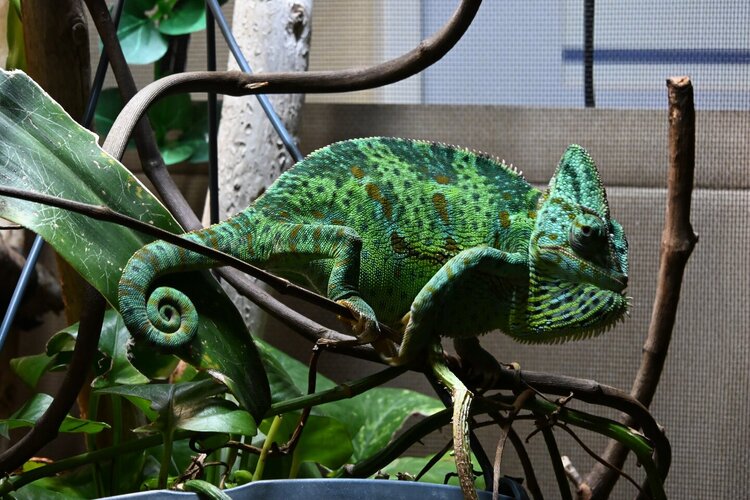 DSC_0645(1).jpg301.4 KB · Views: 68
DSC_0645(1).jpg301.4 KB · Views: 68 -
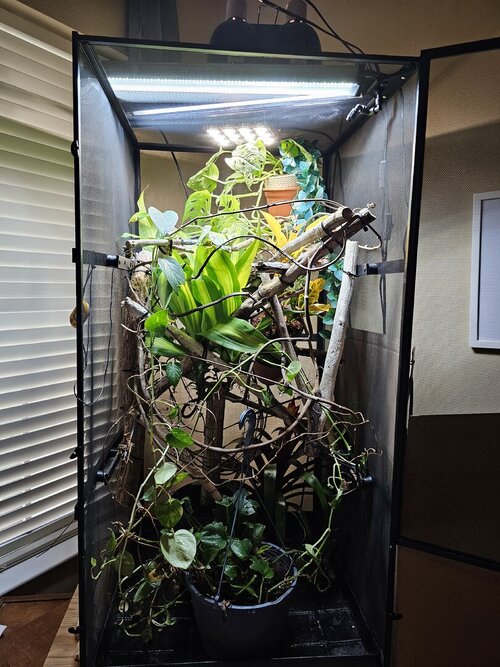 20250510_165310.jpg233.6 KB · Views: 52
20250510_165310.jpg233.6 KB · Views: 52 -
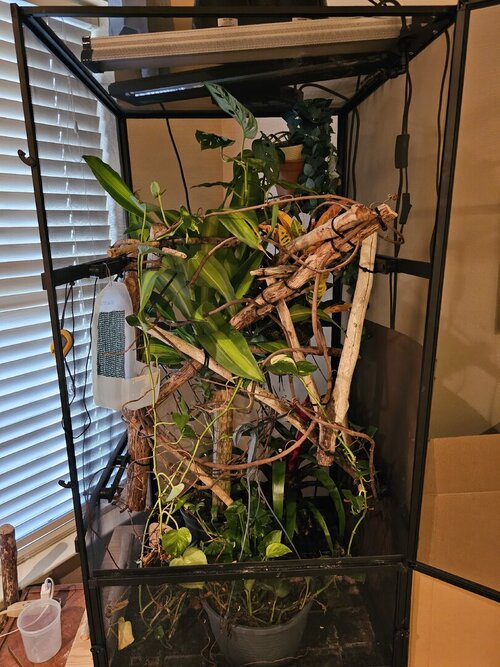 20250524_191845.jpg220.3 KB · Views: 52
20250524_191845.jpg220.3 KB · Views: 52 -
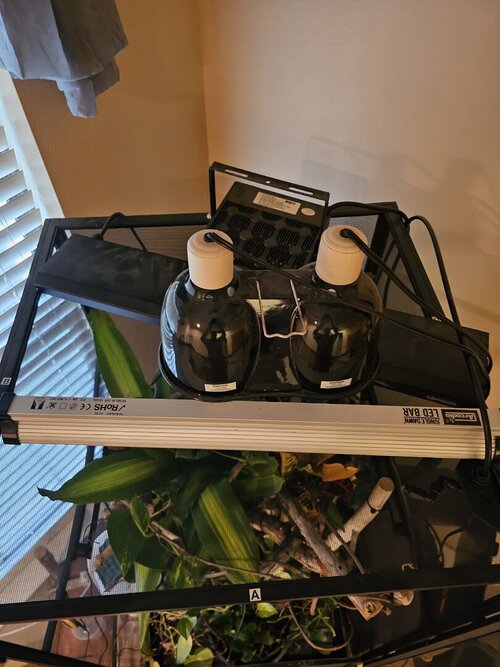 20250524_191852.jpg146.3 KB · Views: 47
20250524_191852.jpg146.3 KB · Views: 47 -
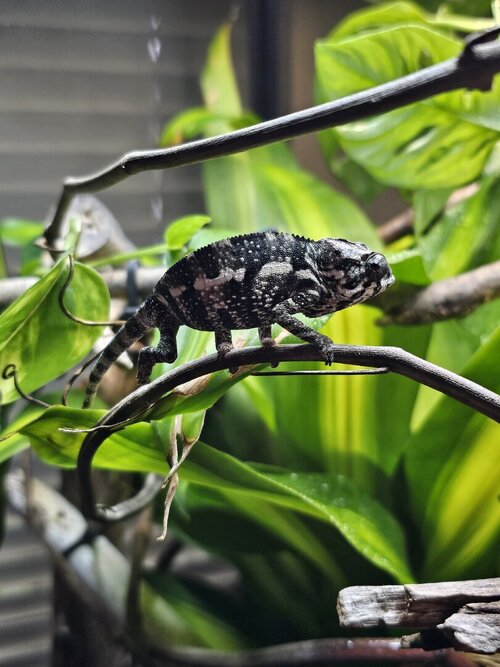 20250510_171628.jpg144.9 KB · Views: 51
20250510_171628.jpg144.9 KB · Views: 51 -
 20250510_171011.jpg277.8 KB · Views: 64
20250510_171011.jpg277.8 KB · Views: 64 -
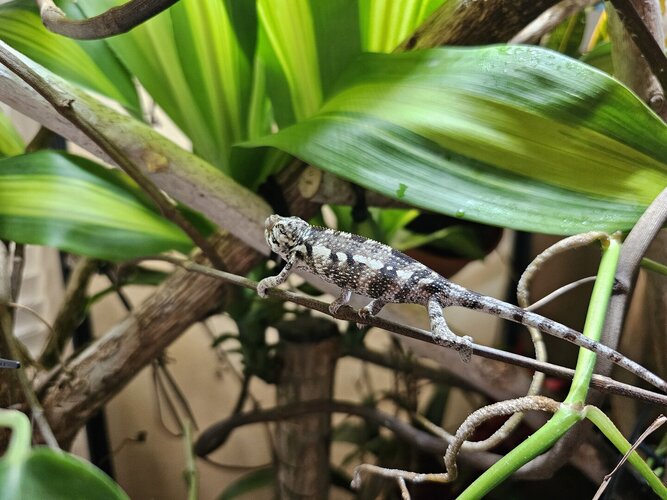 20250510_171008.jpg292.6 KB · Views: 57
20250510_171008.jpg292.6 KB · Views: 57 -
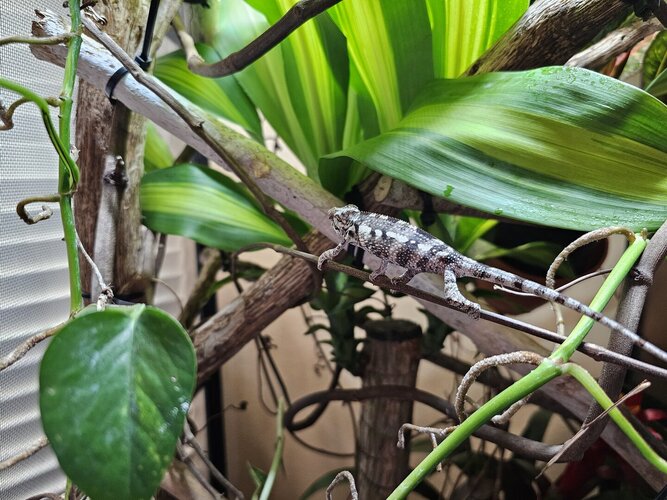 20250510_171005.jpg348.7 KB · Views: 66
20250510_171005.jpg348.7 KB · Views: 66 -
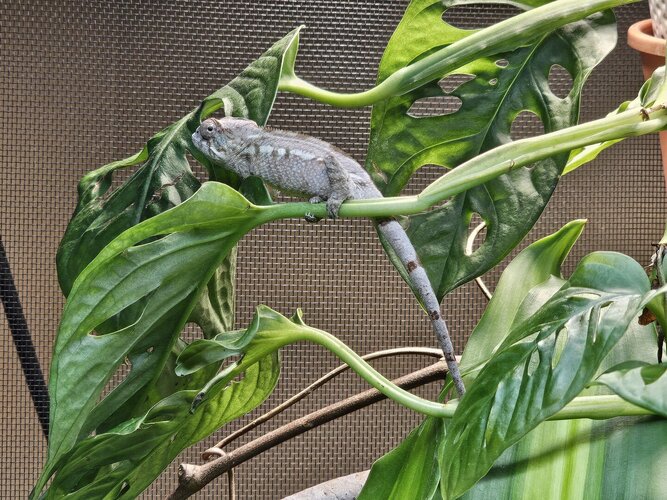 20250513_182052.jpg531 KB · Views: 70
20250513_182052.jpg531 KB · Views: 70 -
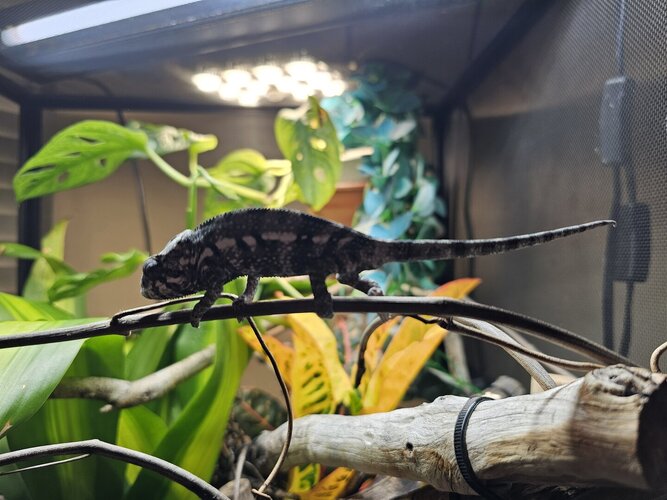 20250518_161529.jpg238.6 KB · Views: 72
20250518_161529.jpg238.6 KB · Views: 72




